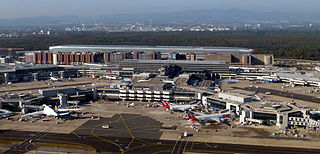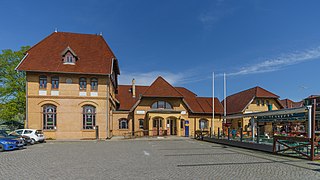
As a densely populated country in a central location in Europe and with a developed economy, Germany has a dense and modern transport infrastructure.

The Hanseatic League was a medieval commercial and defensive confederation of merchant guilds and market towns in Central and Northern Europe. Growing from a few North German towns in the late 12th century, the League ultimately encompassed nearly 200 settlements across seven modern-day countries; at its height between the 13th and 15th centuries, it stretched from the Netherlands in the west to Russia in the east, and from Estonia in the north to Kraków, Poland in the south.

The Volksmarine was the naval force of the German Democratic Republic (GDR) from 1956 to 1990. The Volksmarine was one of the service branches of the National People's Army and primarily performed a coastal defence role along the GDR's Baltic Sea coastline and territorial waters.

Mecklenburg-Vorpommern, also known by its anglicized name Mecklenburg–Western Pomerania, is a state in the north-east of Germany. Of the country's sixteen states, Mecklenburg-Vorpommern ranks 14th in population, It covers 23,176 km2 (8,948 sq mi) making it the sixth largest German state in area, and 16th in population density. Schwerin is the state capital and Rostock is the largest city. Other major cities include Neubrandenburg, Stralsund, Greifswald, Wismar and Güstrow.

Rostock, officially the Hanseatic and University City of Rostock, is the largest city in the German state of Mecklenburg-Western Pomerania and lies in the Mecklenburgian part of the state, close to the border with Pomerania. With around 208,000 inhabitants, it is the third-largest city on the German Baltic coast after Kiel and Lübeck, the eighth-largest city in the area of former East Germany, as well as the 39th-largest city of Germany. Rostock was the largest coastal and most important port city in East Germany.

Warnemünde is a seaside resort and a district of the city of Rostock in Mecklenburg, Germany. It is located on the Baltic Sea and, as the name implies, at the estuary of the river Warnow. Warnemünde is one of the world's busiest cruise ports.

Alexander von Humboldt is a German sailing ship originally built in 1906 by the German shipyard AG Weser at Bremen as the lightship Reserve Sonderburg. She was operated throughout the North and Baltic Seas until being retired in 1986. Subsequently, she was converted into a three masted barque by the German shipyard Motorwerke Bremerhaven and was re-launched in 1988 as Alexander von Humboldt. In 2011 the ship was taken off sail-training and sent to the Caribbean for the charter business, then she was converted to a botel.
Scandlines is a ferry company that operates the Rødby–Puttgarden and Gedser–Rostock ferry routes between Denmark and Germany.

ARM Cuauhtémoc is a sail training vessel of the Mexican Navy, named for the last Mexica Hueyi Tlatoani Cuauhtémoc who was captured and executed in 1525.

A fleet review or naval review is an event where a gathering of ships from a particular navy is paraded and reviewed by an incumbent head of state and/or other official civilian and military dignitaries. A number of national navies continue to hold fleet reviews. Fleet reviews may also include participants and warships from multiple navies.

RV Maria S. Merian is Germany's second most modern research vessel, named after the naturalist and illustrator Maria Sybilla Merian. As of March 2006, Germany operates three other research vessels of its class, none of which is as well-equipped.

Kühlungsborn is a Seebad town in the Rostock district, in Mecklenburg-Vorpommern, Germany. It is situated on the Baltic Sea coast, 11 km northwest of Bad Doberan, and 25 km northwest of Rostock.

Greif is a brigantine, owned by the town Greifswald in Mecklenburg-Vorpommern.

AIDAluna is a Sphinx class cruise ship, owned by US based Carnival Corp and operated by AIDA Cruises. Built by Meyer Werft shipyards in Papenburg, Germany, she is the third ship of the class, preceded by AIDAdiva and AIDAbella, and is followed by AIDAblu, AIDAsol, and AIDAmar. The ship has a capacity of 2,100 passengers and has a gross tonnage of 69,203. AIDAluna was initially deployed in the Baltic Sea for the 2009 Summer season. In Winter 2009, she was redeployed in Canary Islands. AIDAluna has an 8 × 4.5-m poolside theater, which is a first for AIDA Cruises.

The Neustrelitz–Warnemünde Railway is a railway line in the North German state of Mecklenburg-Vorpommern. Most of the line is a double-tracked, electrified main line and runs for almost 130 kilometres from Neustrelitz to Warnemünde. It is also known in German as the Lloydbahn, referring to the Deutsch-Nordischer Lloyd company, which built the line and operated it in its early years after its opening in 1886.
The Mecklenburg Spa Railway is a non-electrified, single track branch line in the north of the German state of Mecklenburg-Vorpommern. It runs from Rövershagen, east of the Hanseatic city of Rostock, to Graal-Müritz on the Baltic coast. Its name came originally from the name of its operator and was later transferred to the line.

The Rostock S-Bahn is a S-Bahn network in Rostock in the German state of Mecklenburg-Vorpommern. It consists of three lines with a total length of about 90 km. Line S1 runs from Rostock Hauptbahnhof to Warnemünde within the Rostock urban area. S-Bahn operations started in 1970s. Later, the lines to the north-east to the port (Seehafen) of Rostock and to the south to the town of Güstrow via Schwaan were included in the S-Bahn network. The line to the port was discontinued in 2012, but at same time the line to Güstrow via Laage was included as line S3 of the S-Bahn. Until 2014 they were mainly operated as push–pull trains with double-deck coaches. Since then all lines have been operated with new Bombardier Talent 2 railcars.

The Weiße Flotte is a shipping company with its head office in Stralsund, Germany, that offers passenger and car ferry services as well as excursions by boat, especially along the Baltic Sea coast of the state of Mecklenburg-Western Pomerania.

Rostock Port is a large German port on the Baltic Sea, it is located on the Unterwarnow estuary in the city of Rostock. Most of the port infrastructure is owned by Rostock Port GmbH, a joint venture between the state of Mecklenburg-Vorpommern (25.1%) and the Hanseatic City of Rostock (74.9%). The port operations are carried out by Euroports Germany GmbH & Co. and other private companies. With a total throughput of 28.8 million tons (2017), the ports of Rostock is the fourth largest German port.

Warnemünde station is located in the seaside resort of Warnemünde, a district of the Hanseatic city of Rostock in the German state of Mecklenburg-Vorpommern. The station opened on 30 September 1903 and is located on the Neustrelitz–Warnemünde railway. It is the terminus of all three Rostock S-Bahn lines. In addition, some long-distance trains serve the station. Until 1995, it was the starting point of ferries to Gedser in Denmark. The station building and some other facilities of the station have heritage protection.





























